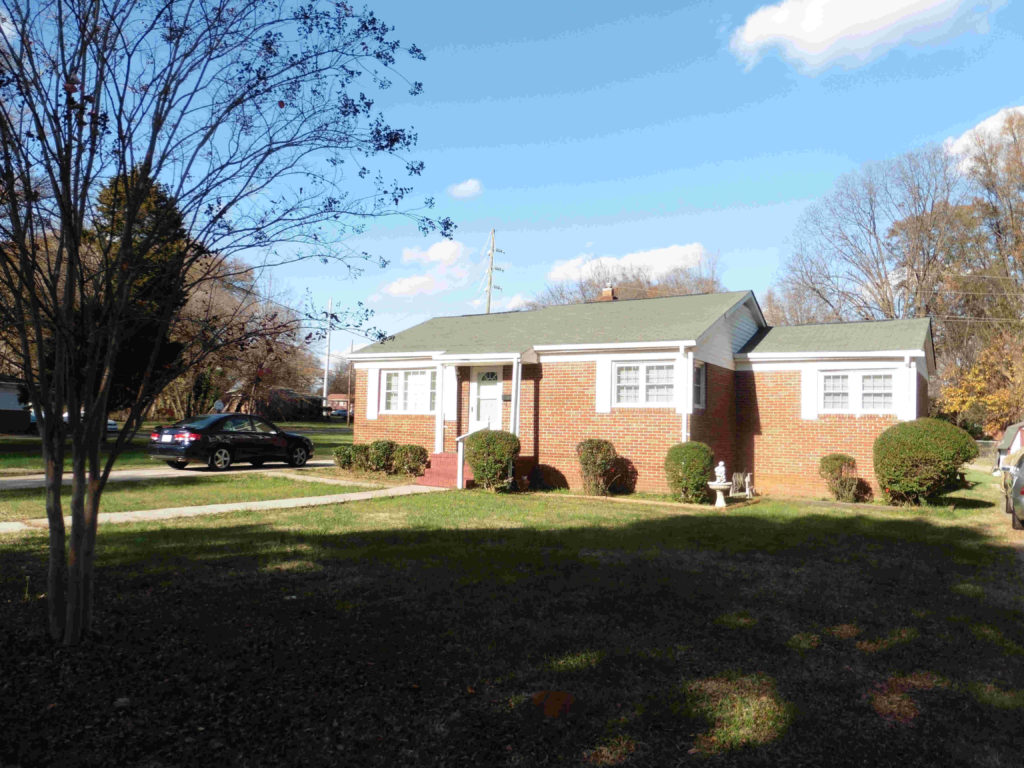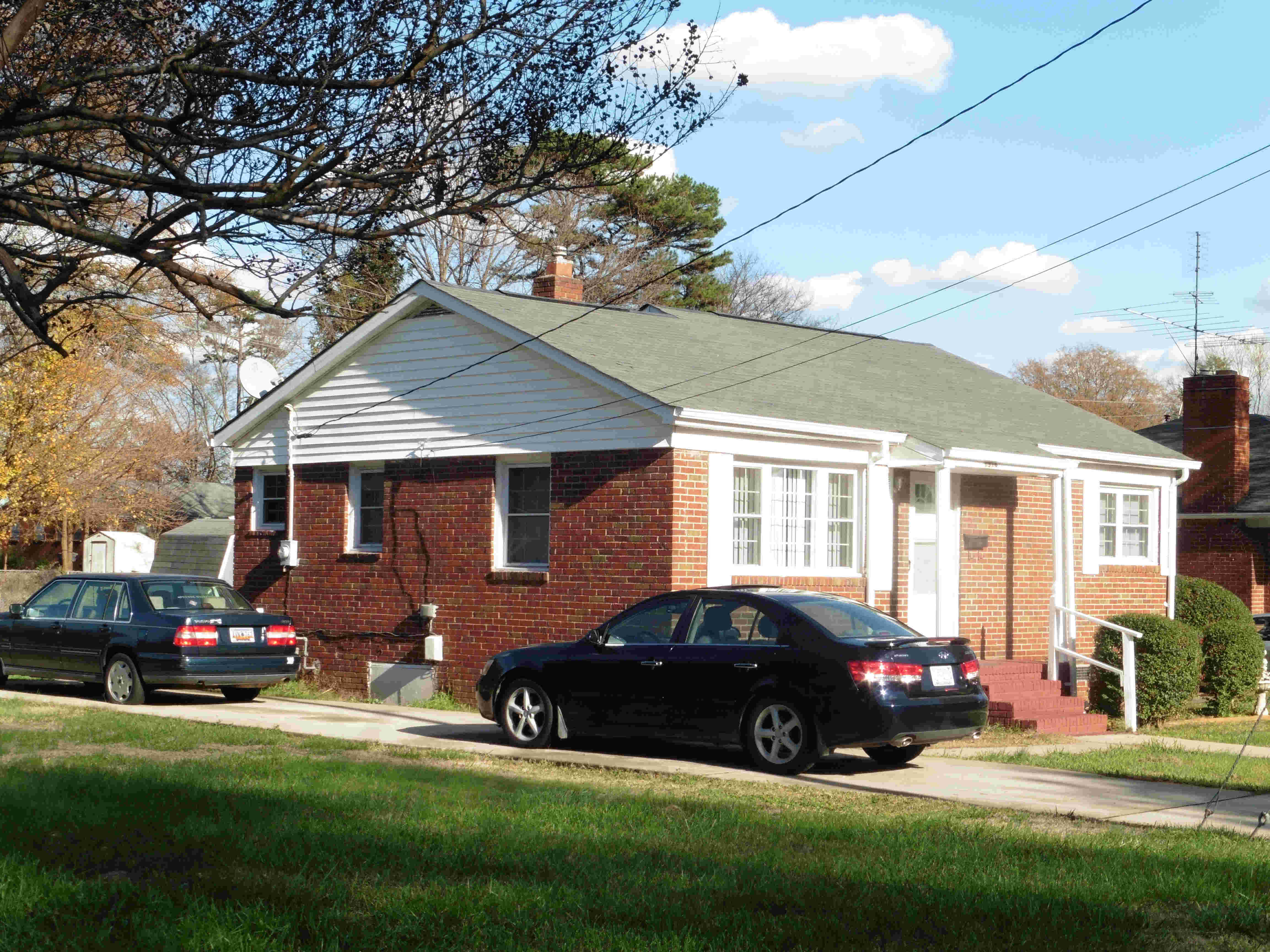1916 Patton Avenue
 First appeared in city directory in 1953, home of Rev. James R. Holloway and wife Christine H. Holloway, a nurse at Charlotte’s black good Samaritan Hospital. Rev. Holloway directed the Mecklenburg Baptist-Interracial Commission, working in partnership with white minister Rev. Claude Broach at St. John’s Baptist Church. It was a rare example of black-white interracial activism prior to the Supreme Court’s 1954 Brown v Board desegregation order.
First appeared in city directory in 1953, home of Rev. James R. Holloway and wife Christine H. Holloway, a nurse at Charlotte’s black good Samaritan Hospital. Rev. Holloway directed the Mecklenburg Baptist-Interracial Commission, working in partnership with white minister Rev. Claude Broach at St. John’s Baptist Church. It was a rare example of black-white interracial activism prior to the Supreme Court’s 1954 Brown v Board desegregation order.
Subsequent residents included Second Ward High School principal Spencer E. Durante in the late 1950s.
******
While Rev. James Holloway’s work with the Mecklenburg Baptist Inter-racial Commission was the family’s most important contribution to Charlotte, an obituary of Christine Holloway gives a sense of the couple’s active life of service: “Mrs. Christine Heard Holloway was born March 27, 1922 in Elberton, GA. and passed away on April 23, 2010 in Powder Springs, GA. A very talented registered nurse, she was the wife of the late Rev. James R. Holloway, serving as a nurse and minister’s wife, she was known for her sense of fairness and her belief in the betterment of mankind and diligently worked in the general and church communities in Belmont and Charlotte, N.C., Cambridge, MA, Minneapolis, MN and Marietta, GA. She leaves to cherish her memory, son, Bishop Edwin and Pastor Kathleen Holloway; son, James R. Holloway, Jr.”
The Mecklenburg Baptist Inter-Racial Commission, Rev. Holloway’s employer during his years in Charlotte, had been established in 1946 by Rev. Claude U. Broach of Charlotte’s white St. John’s Baptist Church. It was inspired by the Commission on Interracial Cooperation, 1919 – 1944, which became a Southern force for progressive activism including key support of Jesse Daniel Ames’ Association of Southern Women for the Prevention of Lynching and Howard Odum’s Institute for Research in Social Science at UNC Chapel Hill. In North Carolina, Baptists were at the forefront of this work thanks to William Poteat, President of the Baptist institution Wake Forest University, who established a North Carolina Commission on Interracial Cooperation active from 1921 into the 1950s.
More research is needed on the Mecklenburg Baptist Inter-Racial Commission and its racial bridge-building work — apparently one of the few such locally focused groups in the South. It seems to have functioned, in part, to get wealthy white congregations to share resources with less-wealthy black ones. A 1953 newspaper article reported that Rev. Holloway would conduct a Leadership Training Institute for Church Workers, open to members of black churches of every denomination in the county. A 1954 story in the black Carolina Times of Durham noted another Commission activity: a Bible study camp “supported by both white and Negro churches” for black children from Charlotte at Lincoln Academy in the countryside west of Gastonia.
Whatever its wider impact, Mecklenburg Baptist Inter-Racial Commission laid the groundwork for a liberalizing of racial thought at St. John’s in particular. Rev. Broach became known for his stance on equality. Remembered a white parishioner: “From the late 1940s through the mid 1970s, this Southern gentleman would invite both Catholic priests and black ministers to the church for visiting sermons, and unheard-of practice in Southern Baptist circles in those days.”
Eight years into the Commission’s existence the U.S. Supreme Court issued its famous Brown v Board desegregation decision. Rev. Broach at St. John’s became one of the few Southern mainline white ministers to take a strong stand in favor. According to a 1972 church history: “In May of 1954, the community was pondering the results of the Supreme Court ruling banning segregated schools. Dr. Broach preached a sermon on ‘The Christian Conscience and Segregation’ which drew an outpouring of endorsement and appreciation. To those who opposed his position of support for the Court decision, Dr. Broach said, ‘For their right to differ, I will contend heartily and cordially. The freedom of dissent is vital in our Baptist heritage. It is a sign of life. If we maintain the spirit of love, our differences are stimulating but not divisive. So may it be!'” He went on to reference the 1946 creation of the Mecklenburg Baptist Inter-racial Commission, saying that “the idea was rather paternalistic, but it was a worthy idea in its time. ‘Today we work with rather than for the black community,’ he said.” In 1956 the St. Johns congregation “voted to accept responsibility for the Sunset Road Baptist Chapel in the northern section of the county. Into this Chapel and its program, St. John’s has poured many hours and many dollars. Through the Missions Committee and especially through the faithful work of Mr. Lewis Burgess, this Chapel has become a strong, cooperating Baptist Church.”
******
City directory listings indicate that Rev. Holloway left this house in the late 1950s. The 1959 directory showed Spencer Durante residing there with wife Rosalia while the Durante family built a new house elsewhere in McCrorey Heights at 1615 Van Buren Avenue. Durante was principal of Second Ward High, one of black Charlotte’s most important leadership positions in that era. From about 1967 into the 1970s, the dwelling was home to David J. Abraham, Jr., a barber at the Fairview Barbershop, and wife Rosetta J. Abraham, a teacher at Double Oaks School.

Architecture
One-story Ranch style house in red-brick. The main block of the house has a gable roof, and a smaller gable-roofed wing extends at the west side. There is a small shed-roofed front porch with slender paired columns.
First appeared in city directory
1953. Rev. James R. Holloway and Christine H.
He: Director, Mecklenburg Baptist Inter-racial Commission. She: Nurse, Good Samaritan Hospital.
City directory collection, Robinson-Spangler Carolina Room, Charlotte Mecklenburg Library.
Resources
“Commission on Interracial Cooperation,” in Hill, Samuel S., Charles H. Lippy and Charles Reagan Wilson, Encyclopedia of Religion in the South, 2nd edition (Macon, Georgia: Mercer University Press, 2005), pp. 226 – 227.
Hall, Randal L., William L. Poteat, A Leader of the Progressive-Era South (University of Kentucky Press, 2015), p. 191.
Holloway, Christine. Obituary in the Atlanta Journal Constitution, April 28, 2010. On-line at: http://www.legacy.com/obituaries/atlanta/obituary.aspx?pid=142303906
Mullen, Donald C., A Radical Change of Direction: Memoir of a Spiritual Journey of a Surgeon (Bloomington, Indiana: WestBow Press, 2015). On-line at: https://books.google.com/books?id=8TS1CgAAQBAJ&pg=PT262&lpg=PT262&dq=Claude+Broach+%22St.+John%27s%22+desegregation&source=bl&ots=yLcWeqNJLN&sig=_B0qkqHBvvQyofCInVAgmDc2v08&hl=en&sa=X&ved=0ahUKEwjMh96Z4rXTAhWl0YMKHUnkAvQQ6AEIOjAF#v=onepage&q=Claude%20Broach%20%22St.%20John’s%22%20desegregation&f=false
“North Carolina Commission on Interracial Cooperation,” Wikipedia website. On-line at: https://en.wikipedia.org/wiki/North_Carolina_Commission_on_Interracial_Cooperation
“North Carolina Commission on Interracial Cooperation Records, 1922-1974,” finding guide, collection 03823, Southern Historical Collection, UNC Chapel Hill. On-line at: http://finding-aids.lib.unc.edu/03823/
Pilkington, Charles Kirk, “The Trials of Brotherhood: The Founding of the Commission on Interracial Cooperation,” Georgia Historical Quarterly (Spring 1985), pp. 55 – 80.
Young, Richard L., and J. Kenneth Sanford, Fifty Favored Years: A History of St. Johns Baptist Church (privately published, 1972) Charlotte. On-line at: http://digital.ncdcr.gov/cdm/ref/collection/p249901coll37/id/23796
Building permit files, Robinson-Spangler Carolina Room, Charlotte Mecklenburg Library.